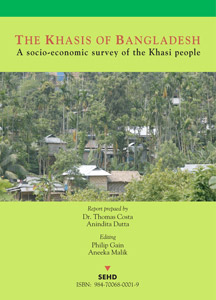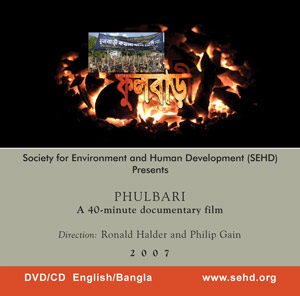
The Khasis of Bangladesh: A Socio-economic Survey
A socio-economic survey of the Khasis, their present status, population, social system, education, livelihood, etc.
2007, English, 60 pages, Paperback | Tk.150 / US$5
The Khasis are believed to be one of the indigenous groups who started to populate the Indian sub-continent ten to twenty thousand years ago. With the greater number of them living in India, this matrilineal ethnic group resides mainly in 11 Upazilas of the greater Sylhet District in the Northeastern region of Bangladesh.
According to the government census of 1991, the Khasi population in Bangladesh is 12,973. However, a great deal of controversy exists over this number. The existing accounts of different sources show a discrepancy as well.
It is in this context that the Society for Environment and Human Development (SEHD) conducted a socio-economic survey of the Khasi people from October 2005 to March 2006. The outcome is the report—The Khasis of Bangladesh: A socio-economic survey of the Khasi people.
The villages that the Khasis live in are called punjis. These punjis are normally located on the hillocks. A punji is an attractive destination for anyone taking interest in this unique indigenous community. There are 85 Khasi punjis in Bangladesh. SEHD wanted to cover all of them in its survey. However, it was possible to carry out the survey in 60 punjis. The basic information of the remaining 25 was collected and is provided in the report.
SEHD conducted the survey with the involvement and cooperation of Greater Sylhet Indigenous People’s Forum (GSIPF). The report presents a brief history of the Khasi people and important information on their present status, population, social system, education, livelihood, etc.
A write-up on Lyngngam (also spelt Lyngam), a small section of the Khasis, is appended with the main report. The Lyngngams live in ten villages of Kalmakanda Thana in Netrokona District. Their culture has a great deal of similarity with that of the Garos. The Garos call them Megam. There is no mention of Lyngngam in the population census.
The 60-page survey report also contains photographs, maps, and list of all Khasi punjis and basic information on the punjis. The report is expected to be beneficial to anyone interested to know the Khasis. The report also brings significant tips for the researchers who may home deep interest in the Khasi community.
Publication Details
Published: 2007
Language: English
Paperback: 60 pages
Prepared By: Dr. Thomas Costa and Anindita Dutta
Price: Tk.150 / US$5

